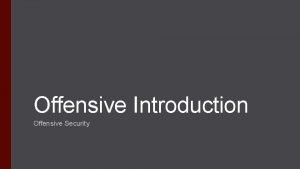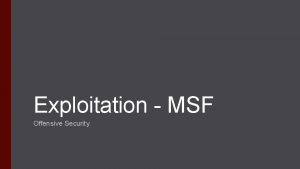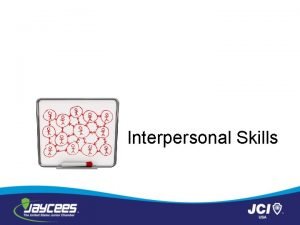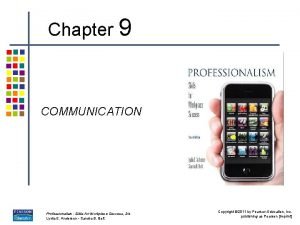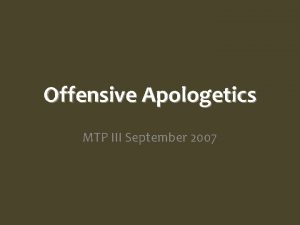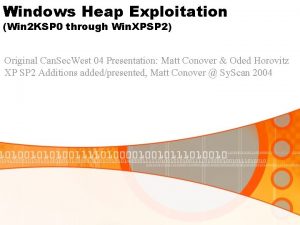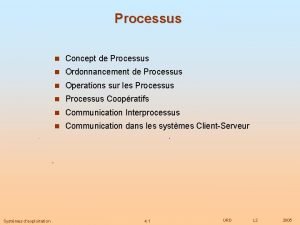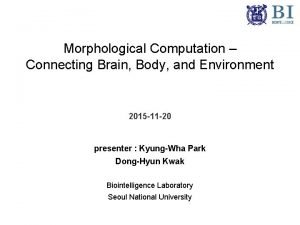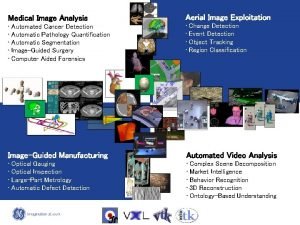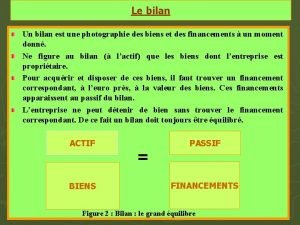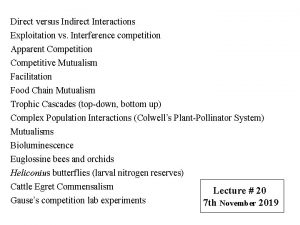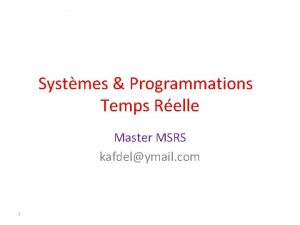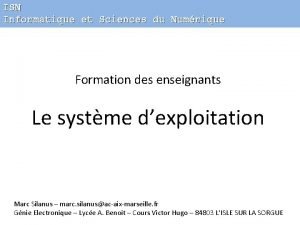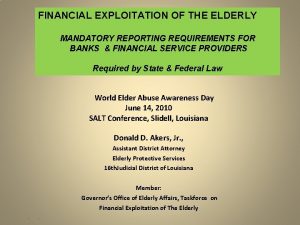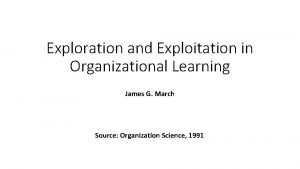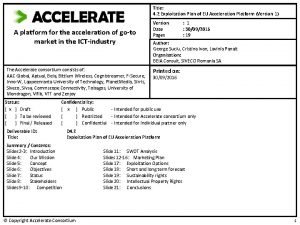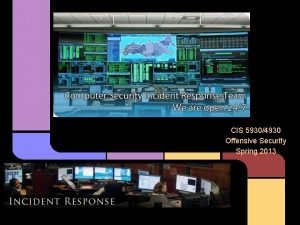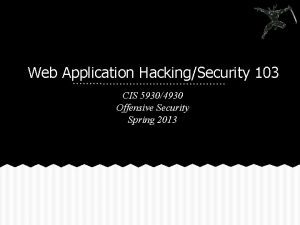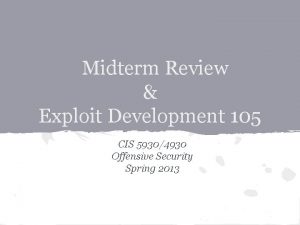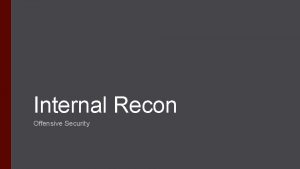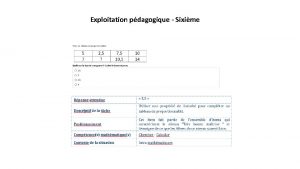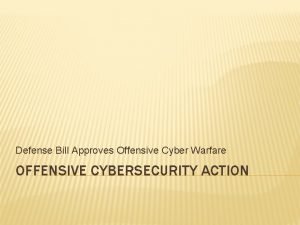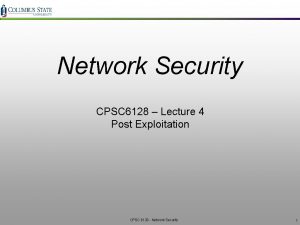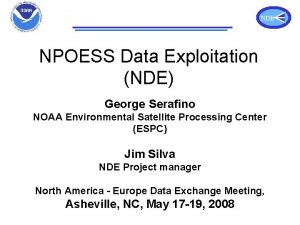Post Exploitation CIS 59304930 Offensive Security Spring 2013





















![Windows Access Token - [In Microsoft OSes] is a [kernel] object that contains the Windows Access Token - [In Microsoft OSes] is a [kernel] object that contains the](https://slidetodoc.com/presentation_image_h/c963e9d8fb3e86c339078e9665ea846f/image-22.jpg)































- Slides: 53

Post Exploitation CIS 5930/4930 Offensive Security Spring 2013

Some fun news http: //danfarrall. com/gchq/ GCHQ (British equivalent of the NSA) discovered storing passwords in cleartext / reversible encryption. • o enter your email into the "I forgot my password" form, and they email your password in cleartext. . .

Outline of Talk • Overview of Post Exploitation Basics o Tools o Goals o • Credentials/Authorization Overview Passwords o 2 -Auth o Linux (recap) o Windows Access Tokens (new) o • Meterpreter o Passing the Hash

Related Resources • • Windows Internals books Sys. Internals Suite http: //technet. microsoft. com/enus/sysinternals/bb 545021. aspx Security Implications of Windows Access Tokens - A Penetration Tester's Guide http: //labs. mwrinfosecurity. com/assets/142 /mwri_security-implications-of-windowsaccess-tokens_2008 -04 -14. pdf http: //www. darkoperator. com/

Post Exploitation: "Ok I hacked it, now what? " Is about making the most out of every successful exploitation Common Activities / Targets: User credentials (for password cracking) Maintaining access Covering tracks Expanding attacker control Pivoting / passing the hash • • •

Post Exploitation Techniques, Approaches, and Tools: Entirely architecture/platform specific • o • requires familiarity with target environment § Windows, *nix, Android, OSX, etc. . . Depends on the security model of target system o can differ drastically from platform to platform

Post Exploitation (Theory) • Application / Software / Network security has improved over the past decade o • Applications have also grown more complex o • Defense in Depth, Layers, Multi-factor auth May be able to get at your target indirectly § Exploit A, to get to B Attackers can no longer just directly hack their target o inch by inch, incremental progress

Post Exploitation (Theory) • Exploit existing system: features o Trust relationships o Account privileges o Account access across the network o ROOT

A Brief Overview of Authorization

Credentials Overview Whenever a user/entity makes a request to perform an action on an object, they must present credentials. • • (i. e. read a file) user/pass, biometrics, certificate, token, session ID The decision (permit / deny) is made with reference to the access control(s) of the system MAC DAC • •

Access Control in Linux • • Users are made very aware of permissions (and permissions related problems) o Most experienced users understand the permissions system o • ls -l Thus is commonly, well-understood by security / system admins Machine - to - Machine access is not streamlined, unless specially set up to be. o ssh & ssh keys

Recap (Linux) RUID = real user id. is the identity of the logged in user who launches programs. set when the user logs in, and can only be changed by a root user. Also process signalling is controlled by ruid • • • o Process X can only signal process Y if process X has the same ruid as Y, or is root ruid.

Recap (Linux) EUID = effective user id Is the UID used to judge privilege and access permission. In most cases, this is the same as ruid. • • o • But if a program were flagged with the setuid bit, then when it is executed, it is assigned the euid of the owner of the program. Also the setuid() or seteuid() functions allow the be changed But for what is EUID used into Windows to judge privilege and access permission?

Windows Security Model

Windows Access Control DAC How owners specify specific permissions on a user by user basis for a object. Privileged Access Control How Administrators gain access to other user's objects (i. e. employee is fired. . . ) MIC/MAC (or Mandatory Integrity Control) Used to prevent non-elevated accounts from accessing elevated objects & to isolate Protectedmode processes o i. e. a protected process from accessing unprotected configuration files • • •

Windows Security Model Subject - synonymous with "User" Security Descriptor - contains the security information associated with a securable object. The descriptor can include: • • Security Identifiers (SIDs) for the owner/group DACL - Specifies the rights for specific users/groups SACL - Like DACL but for auditing control flags - to describe the Security Descriptor

Windows Security Model Object - "a kernel object is a single, run-time instance of a statically defined object type" - Windows Internals 6 th edition, pt 1, page 21. Object protection & Access logging are the essence of discretionary access control & auditing. Objects usually contain a security descriptor. . • •

Windows Access Tokens

Objects. . . Objects are essentially: A class/struct for holding attributes / functions • o A process is an instance of the process object type Object attributes: data field for holding some info about the object's state • Process ID o Scheduling priority # o Pointer to access token object o

Examples of Objects? • • Anything managed by the Executive Object Manager. . files, devices, mailslots, pipes (named & anonymous), jobs, processes, threads, events, keyed events, event pairs, mutexes, semaphores, shared memory sections, I/O completion ports, LPC ports, waitable timers, access tokens, volumes, window stations, desktops, network shares, services, registry keys, printers, Active Directory objects, etc. . .

Windows Security Model
![Windows Access Token In Microsoft OSes is a kernel object that contains the Windows Access Token - [In Microsoft OSes] is a [kernel] object that contains the](https://slidetodoc.com/presentation_image_h/c963e9d8fb3e86c339078e9665ea846f/image-22.jpg)
Windows Access Token - [In Microsoft OSes] is a [kernel] object that contains the security information for a login session, and identifies: The user o The user's groups o and the user's privileges o Windows Access Tokens are commonly not well-understood by most o Often, the confusion about it is akin to quantum

Windows Access Tokens What is a login session? All the activity between login and logout in a multi-user OS • o maintained by kernel o controlled by the Local Security Authority Subsystem Service (LSA / LSASS) o winlogon loads the user's profile upon login Machine - to - Machine access is streamlined during a login session (via access tokens) • user's aren't re-prompted for credentials when operating on remote systems on the domain. . .

Windows Access Tokens Responsible for describing the security context of a process/thread Object Body Attributes Used by the kernel, to make access control decisions. Services Threads inherit the parent process's primary token ACCESS TOKEN Security ID Group ID Privileges Default owner Primary group Default ACL Create token Open token Query token info Set token info Duplicate token Adjust token privileges Adjust token groups

Windows Access Tokens What gets access tokens? Each process • o • & Each thread (Windows is a multithreaded environment) Processes have a primary token associated, which dictates their privileges o primary token not to be confused with token types/security levels

Windows Access Tokens Two main types of tokens: Primary (All processes/threads have one) Impersonation Tokens have 4 different security levels: Anonymous Tokens Identification Tokens Impersonation Tokens • • • o & Delegationlogons are the one's we are result (normally) from Impersonation non-interactive interested in for now --- they can be used to assume a Delegation Tokensdifferent security context!!! o quite interesting

Windows Access Tokens Impersonation tokens Even if another token is the primary token, if an impersonation token is present, allows the thread/process to act under a different security context • o commonly used by developers to allow SYSTEM or the windows kernel to handle special functions (like Windows Auth).

Windows Access Tokens Delegation tokens Allows thread/process to impersonate the security context of the given token on ANY OTHER system [in the domain] • o as long as that token is valid on that system


Abusing Tokens • Tokens may be present on compromised systems may allow for privilege escalation o may allow for pivoting within the Domain o • Attackers want to enumerate available tokens o Tools: Incognito (part of Metasploit) The SYSTEM token is the holy grail of token stealing

Abusing Tokens Meterpreter has many nice features Here is an example of listing all the tokens, having already compromised a SYSTEM token. The SYSTEM token allows us to access everything in the system, and here we see the full list of tokens

Impersonating Tokens Example of abusing impersonation tokens

Incognito commands

Abusing Tokens Local Privilege Escalation Impersonation tokens may allow this if present Example: • • Attacker compromises some server/service b. Any administrators who connect using windows auth, will expose their token to the attacker c. Attacker uses token to escalate to local administrator a. Administrator Exploited Process Windows Auth Network Service Client Process

Abusing Tokens Pivoting Administrator Delegation tokens may allow this if present Administrator Example: • • Remote System Attacker compromises some server/service Administrator Remote b. Any administrators who connect using windows System auth, will expose their token to the attacker Remote c. Attacker uses token to escalate to local System administrator, and perhaps even on other systems. a. Administrator Exploited Process Windows Auth Network Service Client Process

Post Exploitation: Relevant Windows Features Active Directory For getting around easily LSASS For stealing passwords Network logon services (netlogon) For establishing hidden users • • •

Meterpreter

Meterpreter An advanced, dynamically extensible payload uses in-memory DLL injection stagers extended over the network at runtime • • Mixture of C / Ruby components. Client = Ruby Server = C • •

Meterpreter 1. The target executes the initial stager. This is usually one of bind, reverse, findtag, passivex, etc. 2. The stager loads the DLL prefixed with Reflective. The Reflective stub handles the loading/injection of the DLL. 3. The Metepreter core initializes, establishes a TLS/1. 0 link over the socket and sends a GET. Metasploit receives this GET and configures the client. 4. Lastly, Meterpreter loads extensions. It will always load stdapi and will load priv if the module gives administrative rights. All of these extensions are loaded over TLS/1. 0 using a TLV protocol.

Meterpreter Designed as a payload to be: Stealthy • resides entirely in memory (nothing on disk) o no new processes created, injected into compromised process § can migrate to other processes o Always uses encrypted communication o • • Powerful o Feature-rich and encrypted Extensible o Features can be augmented at runtime over the

From the Defender's Perspective 1) Encoded exploit + (reverse) Meterpreter payload (perhaps staged) Metasploit + Meterpreter 3) outgoing TLS/SSL connection back to attacker 4) Encrypted pwnage F I R E W A L L Administrator Vulnerable Service 2) Vuln service is injected with the Meterpreter DLLs Say the attacker manages to exploit a vulnerable service through the firewall (say port 80) Can a network-based IDS system detect any part of this?

Meterpreter Features See: http: //www. offensive-security. com/metasploit-unleashed/Meterpreter_Basics Designed to provide similar functionality to linux shells ls (instead of dir) cat cd & pwd getuid ipconfig (actually windows style) ps • • •

Meterpreter Features • • • upload o download file from victim getsystem o • send file to victim will attempt a number of ways to steal & use a SYSTEM token (5 or so ways) hashdump (windows) will dump the contents of the SAM database o requires system o • See http: //www. darkoperator. com/tools-and-scripts/ for dumping

Meterpreter Features Demo of getsystem & hashdump fails without SYSTEM privileges •

execute, ps, migrate demo

Meterpreter Features webcam_list & webcam_snap (from http: //www. offensive-security. com/metasploit-unleashed/Meterpreter_Basics)

Meterpreter Features: User interface commands

Pass the hash In certain cases, it is not necessary to crack password hashes. They sometimes are used as-is in machine-to-machine authentication on the Domain (NTLANMAN/LANMAN) allows attacker to quickly pivot into other systems • • Metasploit: windows/smb/psexec •

Other ways to pivot SSH keys (linux) usually in ~/. ssh/ • Active Directory NTDS. DIT file • Password reuse emails + spear-phishing netlogon / ssh CMS logon / web application logon • • •

Maintaining Access Goals: survive reboot/BSOD/crash survive patching survive/avoid discovery Windows: Incognito • • • o add users autorun? Linux: Can add users with root shell access •

Advanced Leveraging the Win 32 API with Meterpreter's RAILGUN irb • command to drop into meterpreter scripting mode o can access meterpreter modules and devise custom scripts o Injecting backdoors disguised as bugs • • • Stuxnet did this in existing applications in the kernel?

Conclusion These are just the basics One's post-exploitation kung-fu is limited only by one's creativity and system familiarity •

Next time Using Volatility to analyze post exploitation / exploits!
 Intro to offensive security
Intro to offensive security Metasploit pros and cons
Metasploit pros and cons Security private
Security private E sign ssp
E sign ssp Giduk
Giduk Spring seasons months
Spring seasons months Monica brewed espresso steamed milk
Monica brewed espresso steamed milk Being zealous without being offensive means---
Being zealous without being offensive means--- Defensive line get off drills
Defensive line get off drills Intentional use of unfriendly or offensive behavior
Intentional use of unfriendly or offensive behavior Types of offensive strokes in table tennis
Types of offensive strokes in table tennis Macaroni penguin offensive adaptations
Macaroni penguin offensive adaptations Offensive rationale for government intervention
Offensive rationale for government intervention Backspin counterpart to the offensive loop drive
Backspin counterpart to the offensive loop drive Parallel structure means
Parallel structure means Offensive language in the workplace
Offensive language in the workplace Offensive language in the workplace
Offensive language in the workplace Offensive language in the workplace
Offensive language in the workplace The tet offensive
The tet offensive Unitary actor realism
Unitary actor realism Paragraph with parallelism
Paragraph with parallelism What is defensive realism
What is defensive realism The least offensive play in the whole darn world
The least offensive play in the whole darn world A blue ocean type of offensive strategy
A blue ocean type of offensive strategy Offensive apologetics
Offensive apologetics Meuse argonne offensive apush
Meuse argonne offensive apush Windows heap exploitation
Windows heap exploitation Système d exploitation
Système d exploitation Exploitation
Exploitation Image analysis and exploitation
Image analysis and exploitation Hors exploitation
Hors exploitation Exploitation plan example
Exploitation plan example Exploitation
Exploitation Child beauty pageants history
Child beauty pageants history Interference competition
Interference competition Chapeau ferraillage
Chapeau ferraillage Exploitation competition
Exploitation competition Definition of sexual exploitation
Definition of sexual exploitation What is new entry in entrepreneurship
What is new entry in entrepreneurship Risk reduction strategies for new entry exploitation
Risk reduction strategies for new entry exploitation Q learning exploration vs exploitation
Q learning exploration vs exploitation Child exploitation and obscenity section
Child exploitation and obscenity section Systeme d'exploitation
Systeme d'exploitation Dave aitel immunity
Dave aitel immunity Heap exploitation techniques
Heap exploitation techniques Risk reduction strategies for new entry exploitation
Risk reduction strategies for new entry exploitation Systeme d'exploitation
Systeme d'exploitation Systeme d'exploitation
Systeme d'exploitation Exploitation of the infirmed
Exploitation of the infirmed Exploration and exploitation in organizational learning
Exploration and exploitation in organizational learning Exploitation of labor
Exploitation of labor Exploitation plan meaning
Exploitation plan meaning Consumer movement images
Consumer movement images Definition of child exploitation uk
Definition of child exploitation uk
